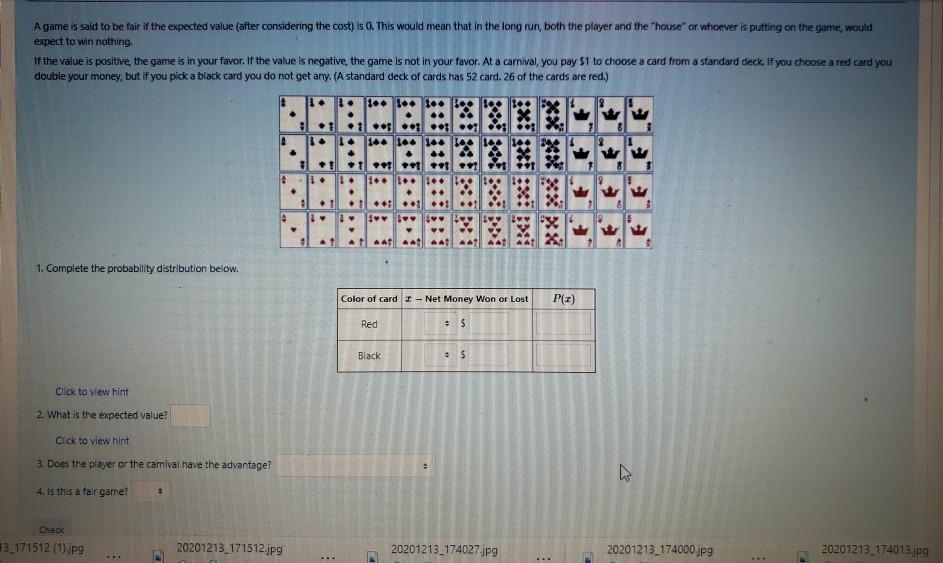QQuestionAnatomy and Physiology
QuestionAnatomy and Physiology
A game is said to be fair if the expected value (after considering the cost) is 0. This would mean that in the long run, both the player and the "house" or whoever is putting on the game, would expect to win nothing.
If the value is positive, the game is in your favor. If the value is negative, the game is not in your favor. At a carnival, you pay $1 to choose a card from a standard deck. If you choose a red card you double your money, but if you pick a black card you do not get any. (A standard deck of cards has 52 card, 26 of the cards are red.)
1. Complete the probability distribution below.
| Color of card | z | Net Money Won or Lost | P(z) |
| --- | --- | --- | --- |
| Red | | $ | |
| Black | | $ | |
Click to view hint
1. What is the expected value?
Click to view hint
1. Does the player or the carnival have the advantage?
2. Is this a fair game?
Check
20201213_171512.jpg 20201213_174027.jpg 20201213_174000.jpg 20201213_174013.jpg
Attachments

6 months agoReport content
Answer
Full Solution Locked
Sign in to view the complete step-by-step solution and unlock all study resources.
Step 1: Complete the probability distribution table.
| Black | -$1 | -$1 | 1/2 |
The probabilities of drawing a red or black card from a standard deck are given by: - P(Red) = number of red cards / total number of cards = 26 / 52 = 1 / 2 - P(Black) = number of black cards / total number of cards = 26 / 52 = 1 / 2 We can now fill in the table as follows: | Color of card | z | Net Money Won or Lost | P(z) | | --- | --- | --- | --- |
Step 2: Calculate the expected value.
E = (1/2) * ($1) + (1/2) * (-$1)
The expected value is calculated as the sum of the product of each outcome's value and its corresponding probability: E = ∑ P(z) * z E = $0
Final Answer
1. The probability distribution table is completed as follows: | Color of card | z | Net Money Won or Lost | P(z) | | --- | --- | --- | --- | | Red | $1 | $1 | 1 / 2 | | Black | -$1 | -$1 | 1 / 2 | 2. The expected value is $0. 3. Neither the player nor the carnival has an advantage in the long run. 4. The game is fair.
Need Help with Homework?
Stuck on a difficult problem? We've got you covered:
- Post your question or upload an image
- Get instant step-by-step solutions
- Learn from our AI and community of students